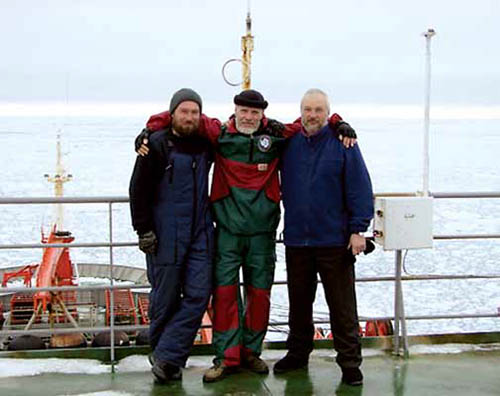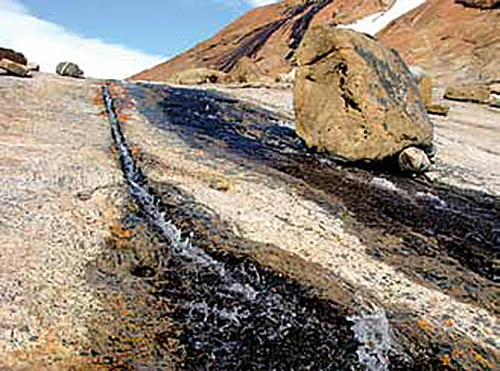
Participants of the Belarusian Antarctic expedition
Whilst we are enjoying winter, in the far Antarctic summer is approaching, so the season for scientific research begins. Five members of the seventh Belarusian Antarctic expedition will work there until the middle of April 2015. As well as scientific research projects, they will be engaged in equipping the platform for our station, which will consist of 8-10 modules fitted with everything necessary for the life and work of polar explorers. The Head of the Polar Research Centre, Oleg Snytin, says that the first stage is expected to be completed by 2018. Alexey Gaidashov is the head of expedition; his team consists of biologist Vladislav Myamin, physicist Mikhail Korol, geophysicist Pavel Shablyko and mechanical engineer Vladimir Alfimov. They will stay at the Russian field camp near Vechernyaya Mountain. The Deputy Director General for Scientific and Innovative Work at the Scientific and Practical Centre of NAS on Bio-resources, and member of the second Belarusian Antarctic expedition, Oleg Borodin, shared his ‘polar’ impressions with MT readers.
The expedition team’s first stop will be in the Republic of South Africa, after which they will take a week long trip by boat on a seven-deck icebreaker to the base. The majority of the workers at foreign polar stations reach the Antarctic expeditions from the opposite direction of South America, which takes about three days. Some brave women purposefully go to give birth on the ice continent so that the baby’s birth certificate will read, for example, ‘this citizen of Argentina was born in Antarctica...’
The vessel shakes violently in the cold waters. The icebreaker comes down over the ice, crushing it with its weight and thus moving forward. The ship does not quite reach Antarctica but stops approximately 70 kilometres from the base. The remainder of the journey has to be undertaken by helicopter. The western Antarctic is more habitable than the East where the Russians and Belarusians are based. Until recently, it was thought that only penguins would be seen in the eastern area, but this is not so. We expect to learn a great deal more about sea fauna; one of the members of the Belarusian expedition will sail with New Zealand colleagues to Ross Sea to study cetaceans and seals.

The presence of people attracts curious penguins. As a rule, mixed groups of these amusing birds approach the station, comprising 30-40 Adelie and a couple of emperor penguins. They clamour for nearly 20 minutes. If the flock is startled, the young Adelie run away, resembling little gnomes with feathers flying in every direction. One of the features of paying court to a female penguin is to give her the gift of a boulder for her future nest. Some particularly active males, misunderstanding completely, have in the past brought stones to the polar explorers.
The sun is so intense in Antarctica, that without protective glasses it is possible to burn ones retina. Even those men who are most resistant to the cold men will need protective lip balm. The speed of the wind on the continent sometimes reaches 54 metres per second! Members of the expedition once tried to measure it more precisely by fastening a volunteer onto a rope and letting him out from beneath the station. The blades of the measuring device were broken and his gloves ripped off, the polar explorer was lifted into the air, he was barely dragged back in. Even the all-terrain vehicles leave the ground in the teeth of such strong winds.
Sometimes the team will uncover some ice and put up a tent near the hole with a stove so that samples can be collected the next day. On one occasion, a sleeping seal was found in the tent on the following morning. The south polar skua also feels comfortable in the Antarctic. At times these seabirds, like geese in size, have snatched the explorers lunch bags.
In the spring Antarctica blooms. At the waterfalls there is multi-coloured water painted with seaweed, and lichen grows on the stones. Underneath boulders on the beach, biologists have found a large number of insects. The phenomenon of one organism parasitizing on the other is very common in cold regions. Our scientists observed how one mite previously unknown to science, eats another never before seen nematode. Many microorganisms can be found in small melt lakes. The visibility of the water can reach 27 metres. Fish living in these lakes will eat everything, a larger fish will also eat the small fish that has swallowed the bait. Belarusian scientists managed to catch fox-fish, Antarctic marbled perch and leech.
One of our expedition team investigated the unique ancient lake Nizhnee. For many thousand of years it was covered by ice which is 1.5-2.5 metres thick, and the water temperature is minus 1 degree. At the same time under the ice there is life: various bacterial forms and huge spheres from microorganisms, which are interconnected. On the outside they are brown and green, whilst the inside can be yellow or orange. It is possible that bacteria and microorganisms previously thought extinct may live there.
Antarctica has a very rich palette of colours and shades. With the naked eye, both the water and snow are dark-blue. By the evening, when the sun goes down, the sky becomes crimson-yellow owing to the extreme cleanliness of the atmosphere. The colours of the Antarctic are so vibrant, one feels almost as if we are on another planet.
By Alena Yasko











